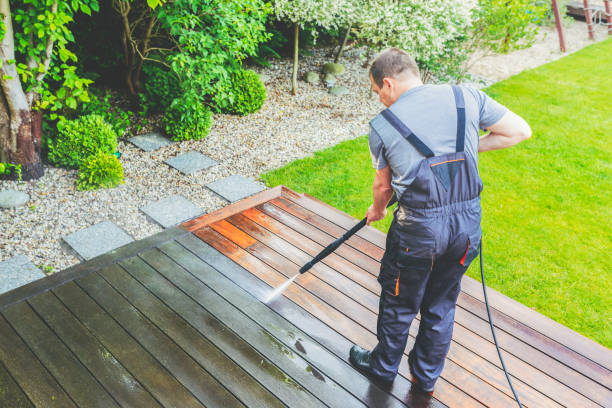A clean, well-maintained deck can enhance the beauty of your outdoor space, making it the perfect place to relax or entertain guests. Over time, however, decks can accumulate dirt, mold, and mildew, which can degrade both their appearance and longevity. Regular deck washing is essential to maintain its condition, restore its natural beauty, and prevent long-term damage.
In this guide, we’ll cover everything you need to know about deck washing in Alton NH, from preparation to techniques, and provide helpful tips to ensure your deck looks brand new.
Why Deck Washing is Important
Decks are constantly exposed to the elements, which can cause a buildup of dirt, algae, mold, and even stains from everyday use. If left untreated, these elements can cause wood to rot, weaken, or become discolored. Regular washing helps:
Prolong the life of your deck
Prevent slip hazards caused by algae and mold
Restore the natural beauty of the wood or composite materials
Increase your home’s curb appeal
How Often Should You Wash Your Deck?
The frequency of deck washing depends on your location and the materials used. In general:
Wooden decks: Should be washed at least once a year, preferably in the spring or summer.
Composite decks: Typically need washing twice a year, as they are less prone to mold but can still accumulate dirt and debris.
Preparing Your Deck for Washing
Before starting, it’s essential to prepare the area:
Remove furniture and plants: Clear the deck completely to avoid damage to your items and ensure a thorough wash.
Sweep the deck: Remove any loose dirt, leaves, and debris using a broom or leaf blower.
Inspect for damage: Look for any loose boards, nails, or cracks that need repair before washing.
Choosing the Right Cleaning Solution
For effective deck washing, you’ll need to choose the appropriate cleaning solution based on your deck material:
Wooden decks: Use a wood cleaner or a mild detergent specifically designed for wood.
Composite decks: Opt for a cleaner designed for composite materials, as harsh chemicals can damage them.
Eco-friendly solutions: There are biodegradable cleaners that are safer for the environment and nearby plants.
Deck Washing Methods: Pressure Washing vs. Soft Washing
Pressure washing: This is an effective way to clean large areas quickly. However, using too much pressure can damage wood surfaces, causing splintering. For wooden decks, it’s best to use a lower pressure setting (500 to 600 PSI).
Soft washing: This method involves using a cleaning solution and a garden hose or low-pressure washer. It’s ideal for more delicate surfaces like composite decks and ensures thorough cleaning without the risk of damage.
Step-by-Step Deck Washing Process
Apply the cleaning solution: Spray the cleaning solution evenly across the deck surface. Let it sit for about 10-15 minutes to break down the dirt and grime.
Scrub the deck: For heavily soiled areas, use a stiff-bristle brush to scrub away the dirt.
Rinse thoroughly: Use a garden hose or a pressure washer on a low setting to rinse off the cleaner and debris.
Allow the deck to dry: Let the deck dry completely before replacing furniture or applying any sealant or stain.
Post-Wash Maintenance Tips
Sealing or staining: After washing, it’s a good idea to seal or stain your deck to protect it from UV damage, water, and mildew.
Regular sweeping: Keep your deck clean by sweeping it regularly to prevent dirt buildup.
Inspect for damage: Regularly check for loose boards, cracks, or signs of wear and tear to address any issues early.
Common Deck Washing Mistakes to Avoid
Using too much pressure: Excessive pressure can damage wood fibers, leaving the surface splintered and rough.
Skipping repairs: Make sure to address any damage before washing, as water can worsen existing problems.
Neglecting the drying process: Always allow your deck to fully dry before staining or sealing to ensure proper adhesion.
FAQs
Can I wash my deck without a pressure washer?
Yes, you can use a garden hose with a spray nozzle and a deck cleaner. While it may take longer than pressure washing, it can be just as effective for smaller decks or those made of delicate materials.
How do I prevent mold and mildew on my deck?
Regular washing and ensuring proper drainage can help prevent mold and mildew buildup. Applying a sealant or stain with mold inhibitors can also protect the deck.
Is it safe to use bleach on my deck?
Bleach can be harmful to wood and nearby plants. It’s better to use a deck-specific cleaner or a mild, eco-friendly solution.
Can I wash my deck in the winter?
It’s best to wash your deck in mild weather, like spring or summer, to ensure it dries properly. Washing during winter could lead to freezing and potential damage.
How long should I wait before staining my deck after washing?
Allow your deck to dry for at least 48 hours after washing before applying a stain or sealant. This ensures the surface is free of moisture, which could prevent proper adhesion.
Summary
By following these steps and maintenance tips, you can keep your deck clean looking pristine and extend its life. Whether you choose to wash your deck yourself or hire a professional, regular care will ensure your outdoor space remains safe, clean, and inviting for years to come.


